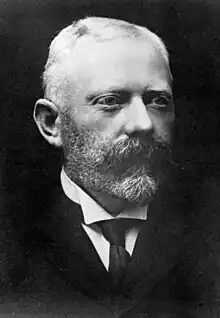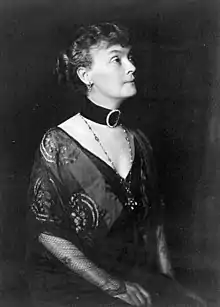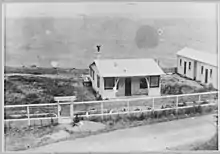Harold Beauchamp
Sir Harold Beauchamp (15 November 1858 – 5 October 1938) was a New Zealand businessman and later two times chairman of the Bank of New Zealand. He is remembered as the father of author Katherine Mansfield.
Sir Harold Beauchamp | |
|---|---|
 Harold Beauchamp circa 1910 | |
| Born | 15 November 1858 |
| Died | 5 October 1938 (aged 79) 88 Hobson Street, Thorndon Wellington, New Zealand |
| Nationality | British subject |
| Known for |
|
| Children | Katherine Mansfield |
| Parent | Arthur Beauchamp |
| Relatives | Elizabeth von Arnim (cousin) |
Australian by birth he was brought to New Zealand at the age of two and eventually made Wellington his home where, still young, he turned a small importing business into a substantial enterprise. He is believed to have crossed the Equator about 24 times travelling by sea to London maintaining business and banking contacts. Beauchamp died in Wellington in 1938 in his eightieth year survived by his second wife.
Youth
Born in Ararat, Victoria, Australia on 15 November 1858 two-year-old Beauchamp moved with his family to Nelson, New Zealand in 1861 and then Picton. His parents were auctioneer Arthur Beauchamp and his wife born Mary Elizabeth Stanley. His father successfully contested the 1866 election for the Picton electorate but resigned in 1867,[1] sold up and moved to isolated Beatrix Bay in Pelorus Sound / Te Hoiere.[2]
After they moved to Wanganui in 1869, Harold attended Wanganui Collegiate School until he left at 14 to work for his father's general merchant and auctioneering business, sometimes as a drover. He appeared in the Magistrate's Court there, aged 15 and charged with "having wilfully damaged the road known as Shakespeare's Cliff Road, by driving a mob of cattle over the clay and mud embankment".[3]
He moved to Wellington and after another two years with his father's new business there went to work for W. M. Bannatyne & Co., the importing firm of W. M. Bannatyne and his partner A. R. Baker. By the age of 26, in 1884, he had done well enough at Bannatyne's to marry. In 1888, he built a house for his growing family. The house, which was the birth place of his daughter, the writer Katherine Mansfield, is now a historic place and preserved as the Katherine Mansfield House and Garden.
Marriage and children

Annie Burnell Dyer married Harold Beauchamp in 1884. She was the daughter of Joseph Dyer (1821–1877) and his wife Margaret Isabella née Mansfield —whose surname granddaughter Kathleen would take as her own.

Annie Beauchamp had six children. Leslie, the youngest, was their only son. Almost their entire married life was spent in one corner of Thorndon though in 1893 they did move to a larger house, Chesney Wold, in semi-rural Karori.[4] 1898 found them back in Thorndon and aside from a few years from 1916 in Wadestown in a house with spectacular views where Annie died, that small part of Thorndon remained the centre of family life.
The three eldest daughters attended Queen's College, London between 1903 and 1906. After their return Beauchamp's personal life took several turns for the worse. His father Arthur died in Nelson in 1910.[5] In the First World War his only son Leslie was killed in Ypres Salient, Belgium in October 1915, aged 21.[6] His mother Mary died in 1917.[7] His wife Annie's health deteriorated and she died in Wellington on 8 August 1918 aged 54.[8] In January 1920 he married widowed Laura Kate Bright, "one of Annie's best friends".[2] In January 1923, his daughter Katherine Mansfield died of tuberculosis in Fontainebleau, France.
W. M. Bannatyne & Co

At the age of 18 Beauchamp went to work for Bannatyne and Bannatyne's partner, A. R. Baker. When he joined the staff was an office junior and a storeman and there was a travelling representative.[9] He did very well, became a partner in 1889 after Bannatyne's death, and stayed with Bannatyne's to the end of his working life. Baker died in 1894 and, to take Baker's place, Beauchamp brought in Walter Nathan, former Tinakori Road next door neighbour —at 96 now 100 Hobson Street. He is reported to have said he made no profits from Bannatyne's until 1890.[2]
Bannatyne's through Beauchamp's efforts became a substantial and prosperous importing and distributing business operating throughout New Zealand. The multifarious items shipped in and distributed ranged from blasting powders and Nobel's Dynamite through teas and coffees to wines, bulk ales and whiskies.
He did not enter politics but did stand for election as a member of the Wellington Harbour Board in 1895 and later served as chairman.
Beauchamp bought another more spacious house in relatively remote Karori but they returned to fashionable Thorndon in 1898 when he joined the board of the Bank of New Zealand.
Walter Nathan died in 1922 and Beauchamp sold Bannatyne's to T & W Young for £150,000. He gave his large house and garden at 47 Fitzherbert Terrace — since wholly excavated for the motorway— to form the core of a fund to buy pictures for the National Art Gallery now subsumed within Te Papa.
Bank of New Zealand crisis
The government had been forced to rescue Auckland's Bank of New Zealand in 1894 and again in 1895 from its undue investment in its property speculations. The real estate was liquidated under government control by a specially constituted Assets Realisation Board —the Board's work dragged on until the end of 1906.[10] Next, in 1896, attempting to be rid of a difficult banking competitor, the Bank of New Zealand over-reached by acquiring control of Dunedin's troubled Colonial Bank of New Zealand[11] but the Bank of New Zealand was obliged to let its undigested partly-owned Colonial Bank subsidiary collapse in 1898. MPs Joseph Ward and William Larnach were among those ruined, Ward was required to quit parliament in 1897 but later restored his financial circumstances. Larnach (the original lead promoter of Colonial Bank and long service director who had freshly displayed his personal confidence in Colonial by buying yet more shares) committed suicide in October 1898 in a parliamentary committee room.[12][13]
New directors were appointed in December 1898 under the Bank of New Zealand and Banking Amendment Act 1898. The Auckland Star reported from Wellington that "after prolonged consideration" the Cabinet had decided to appoint the following directors: J. R. Blair, mayor of Wellington, F. C. Malet of Christchurch, H. Beauchamp of Wellington and William Milne (1849–1942) of Oamaru a former Inspector of the Colonial Bank.[14] Shareholders had previously elected William Watson (1846–1938) and Martin Kennedy both of Wellington to represent their interests.[15]
Chairman
Beauchamp remained a director until 1936. He was chairman of directors from 1907 to 1911 and again from 1913 to 1922.[16] He established relationships with bankers and distinguished authorities on finance in London and in New York and maintained them the rest of his life visiting in person every three or four years.[9]
Federation with Australia
As a member of the 1901 Royal Commission on Federation he advised against New Zealand joining the Australian federation.[17] he attended the Sixth Congress of Federation of Chambers of Commerce of the British Empire and was received by King Edward VII.
Beauchamp was appointed a Knight Bachelor in the 1923 New Year Honours.[18] In 1935, he was awarded the King George V Silver Jubilee Medal.[19]
In his later years, he travelled frequently between London and Wellington and his reports of the trading outlook for New Zealand's primary exports widely reported.[20]
Death and legacy
Beauchamp died in Wellington, on 5 October 1938.[21] He left substantial gifts to the National Art Gallery.[22]
Harold's brother Harry Lomax Beauchamp farmed at Ōtaki for many years and died in 1939.[23]
References
- Scholefield, Guy (1950) [First ed. published 1913]. New Zealand Parliamentary Record, 1840–1949 (3rd ed.). Wellington: Govt. Printer. p. 95.
- Nicholls, Roberta. "Beauchamp, Harold". Dictionary of New Zealand Biography. Ministry for Culture and Heritage. Retrieved 1 April 2012.
- Yska, Redmer (2017). A Strange Beautiful Excitement: Katherine Mansfield's Wellington 1888–1903. Dunedin: Otago University Press. p. 96. ISBN 978-0-947522-54-4.
- Maclean, Chris (21 September 2011). "Chesney Wold". Te Ara – the Encyclopedia of New Zealand. Retrieved 31 March 2012.
- "Marlborough Express – 30 April 1910 – Obituary". paperspast.natlib.govt.nz. 2011. Retrieved 18 October 2011.
- NZ History. Leslie Beauchamp Great War Story. New Zealand Government History site (text and video). Retrieved 13 August 2020
- "Feilding Star – 26 November 1917 – Obituary". paperspast.natlib.govt.nz. 2011. Retrieved 18 October 2011.
- Deaths The Dominion, 9 August 1918, Page 1
- Passing of a Banker. The Evening Post 5 October 1938 Page 14
- Bank of New Zealand, New Zealand Herald 22 June 1907 Page 7
- Banking Enquiry, Auckland Star 29 July 1896 Page 2
- Government intervention, 1890–1940 Te Ara, The Encyclopaedia of New Zealand, 1966
- Disasters and Mishaps — Financial. Colonial Bank. An Encyclopaedia of New Zealand edited by A. H. McLintock, 1966
- Appointment of Directors. Auckland Star 22 December 1898 Page 4
- Election of Two Directors. Auckland Star 22 December 1898 Page 8
- "Former Directors". The Evening Post. 6 August 1936. Retrieved 18 October 2011.
- "AtoJs Online – Appendix to the Journals of the House of Representatives – 1901 Session I – A-04 REPORT OF THE ROYAL COMMISSION ON FEDERATION". atojs.natlib.govt.nz. 2011. Retrieved 18 October 2011.
- "No. 32782". The London Gazette (Supplement). 1 January 1923. p. 2.
- "Official jubilee medals". The Evening Post. 6 May 1935. p. 4. Retrieved 2 July 2013.
- "Evening Post – 30 September 1935 – A BANKER ABROAD". paperspast.natlib.govt.nz. 2011. Retrieved 18 October 2011.
- "Evening Post – 10 October 1938 Notice to Creditors". paperspast.natlib.govt.nz. 2011. Retrieved 18 October 2011.
- "Harold Beauchamp Trust Fund – Collections Online – Museum of New Zealand Te Papa Tongarewa". collections.tepapa.govt.nz. 2011. Retrieved 18 October 2011.
The Harold Beauchamp Trust was the first source of funds dedicated to the acquisition of works of art for the national collection to be donated by a private individual. Sir Harold Beauchamp (1858–1939) was a director of the Bank of New Zealand for thirty-eight years, and father of Katherine Mansfield.
- "Evening Post – 9 August 1939 – OBITUARY". paperspast.natlib.govt.nz. 2011. Retrieved 18 October 2011.